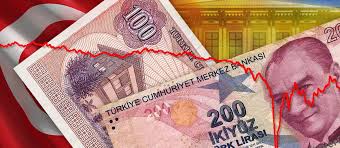The Turkish lira slid to its lowest level in two years on Thursday as investors speculated that its central bank would struggle to stem the currency’s decline amid the coronavirus economic crunch. Turkey’s central bank has run short of foreign-currency reserves and turned to the U.S. for possible help, but analysts say Washington is unlikely to oblige.
Turkey’s lira tumbled 1.1% on Thursday and hit an all-time low tested during the 2018 currency crisis after the banking watchdog clamped down further on foreign access to local markets, exacerbating investors’ concerns over depleted reserves.
The selloff – the worst since mid-April – began begore the conference call between foreign investors and Finance Minister Berat Albayrak that further fuelled the sell-off, analysts and bankers said.
The lira slipped for a sixth straight session and stood at 7.24 against dollar on Thursday morning from 7.14 the day before. At 7.24, it was the worst performer among major emerging market currencies.
The central bank’s net FX reserves have fallen sharply to nearly $25 billion from $40 billion this year. Analysts say that is largely due to its funding of state bank interventions to stabilize the lira, which has nonetheless fallen 17% so far this year.
Compounding worries, Turkey faces a relatively high $170 billion in external debt costs this year.
“They are trying to achieve too many things at once – keep rates low and the currency stable, and they don’t have the reserves,” said Peter Kisler, EM portfolio manager at North Asset Management.
“The one thing that is stopping me from being more bearish is the possibility of still getting a swap line from the Federal Reserve,” he said.
To address the cash crunch, Turkish authorities have reached out to the Fed and other central banks to seek a possible currency swap facility, though no deal has been announced.
Any Fed facility would be conditional on dollar needs, counterparty risk and monetary independence, which analysts have questioned in Turkey.
Swap lines – in which the Fed accepts other currencies in exchange for dollars – are meant to support big foreign dollar markets and not serve as a credit facility. The Fed did not include Turkey when it expanded them to some EMs in March.
HIGH-STAKES CALL
Turkey is starting to slowly ease some measures taken to curb the pandemic, which are pushing its economy into an expected second recession in less than two years.
The last downturn was sparked by a currency crisis that in August of 2018 sent the lira to its weakest level yet.
Late on Tuesday, the BDDK banking watchdog limited lira transactions between Turkish banks and foreign firms to 0.5% of the local lenders’ legal capital, from 1%. Last month it cut the limit to 1% from 10%.
The watchdog said the moves are meant to ensure local financing needs are met amid a slowdown due to the coronavirus pandemic, but some said it was a sign options are running out.
“The market knows that the central bank has few reserves and no swap line with the Fed – which means they have very little ammunition to defend the lira,” said Antje Praefcke, FX and EM analyst at Commerzbank in Frankfurt. “We might be approaching the point of no return.”
Albayrak’s investors call is hosted by banks Citigroup and Societe Generale and closed to the press. He has said the central bank’s reserves were adequate to meet short-term needs and highlighted its gross reserves, which stood at $53 billion.
But markets reflected growing risks including a jump to multi-week highs in both the cost of insuring exposure to Turkey’s sovereign debt, and in volatility gauges.
Turkey “needs a new forex injection,” said a local bank treasury official who requested anonymity. “The lira is heading towards an extremely low value. Any steps that reduce convertibility will be negative in the medium term if they are lasting beyond their short-term effects.”
WSJ, Reuters
